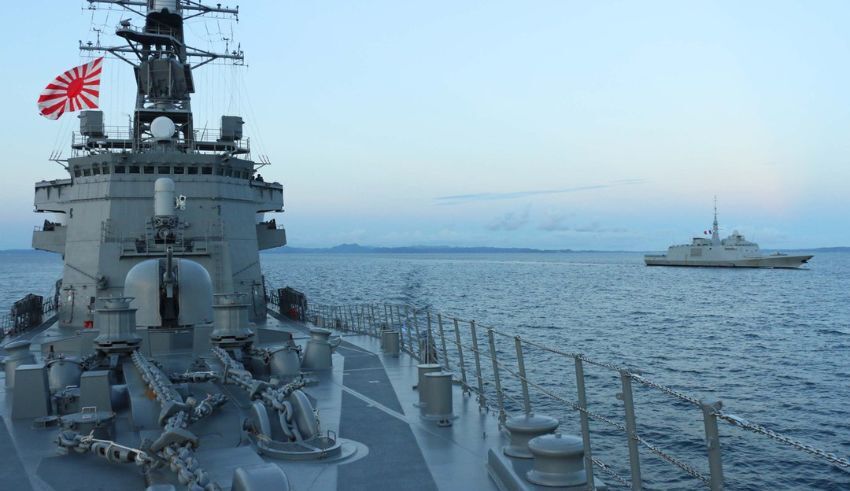
A Japanese battleship has traveled the Taiwan Strait for the first time in modern history, sparking political unrest with China and fundamentally changing Japan’s stance on regional security. Wednesday saw the passage of the JS Sazanami, a Japanese naval destroyer in the Self-Defense Force, under Australian and New Zealand escort ships. As the Japanese vessel was en route to military drills in the South China Sea, it passed the 180-kilometer-wide strait separating Taiwan from mainland China. Japan seems to be indicating a new era of aggressiveness in its regional defense plans, having long refrained from such activities in order to prevent inciting China.
For Japan, a nation that has always concentrated on preserving a fine balance between defending its national security and avoiding direct conflict with China, this historic trip marks a strategic turn-about. Japan’s engagement in the Taiwan Strait indicates its increasing readiness to question Beijing’s hegemony in the area as China keeps strengthening its military presence and claiming territory over Taiwan.
Beijing’s Immediately Reaction and Japan’s Military Operation
Although the government of Japan has stayed formally quiet on the specifics of the operation, claiming military discretion, the passing of the JS Sazanami has not gone unreported. According to Japanese media sources, the presence of the vessel in the strait is related to a more extensive set of military operations in the South China Sea including Australia and New Zealand as well as other foreign allies. Sending a destroyer over these disputed areas helps Japan to more closely align itself with the United States and its allies, who routinely engage in freedom-of-navigation operations to question China’s territorial claims.
China, meantime, reacted quickly to Japan’s unparalleled action. Beijing said on Thursday that its military had been closely monitoring the Japanese destroyer across the Taiwan Strait. Declaring the government’s disapproval, Chinese foreign ministry spokesman Lin Jian said, “China is highly vigilant about the political intentions of Japan’s actions and has lodged stern representations with Japan.” Particularly with relation to delicate territorial issues involving Taiwan and the South China Sea, this diplomatic rhetoric underscores Beijing’s great anxiety about Japan’s growing aggressive posture on matters of regional security.
Chinese official media reflected government worries. The state-run Global Times reported unidentified Chinese military sources confirming that Chinese personnel had closely watched the Japanese and allied vessels all of their trip. The report states that Chinese authorities “maintained control of the situation,” therefore supporting Beijing’s assertion of sovereignty over the Taiwan Strait and the adjacent waters.
The Taiwan Strait: Regional Tension Flashpoint
The Taiwan Strait, a strategically important waterway long cause of conflict between China and the world community, is at the core of this argument. Though at its narrowest point the strait is only 180 kilometers wide, its importance goes much beyond its physical width. With about half of the world’s container fleet traveling through this little tunnel, it is a main commercial and transportation route. Along with its allies, both Taiwan and the United States insist that the Taiwan Strait is part of international seas, hence naval ships from any country should be entitled to sail unhindered through the area. Beijing claims, however, that the strait comes under its authority since it is a component of its larger territorial claim over Taiwan, a renegade province.
For years, the only foreign naval force routinely crossing the Taiwan Strait was the US Navy’s Pacific Fleet. These activities were meant to support the fundamental premise of international marine law, freedom of navigation, But in recent years, a number of America’s closest friends have also started sending warships across the strait to show their support of this idea and their resistance against China’s vast maritime claims. Naval transits across the strait have been carried out by Australia, Canada, Britain, France, and now Japan, underscoring the rising worldwide concern over China’s gaining sway in the area.
Especially remarkable is Japan’s choice to participate in freedom-of- navigation activities. Japan had meticulously avoided passing its navy ships across the strait for decades in order to preserve calm relations with China. But Japan has been had to rethink its strategy as China has grown more forceful in claiming territory in the East China Sea and the South China Sea. By clearly deviating from Japan’s past non-confrontational stance, this latest transit of the JS Sazanami signals Tokyo’s readiness to actively oppose China’s maritime aspirations.
Global Reactions and the More General Geopolitical Setting
Apart from Beijing, Japan’s choice to sail a warship across the Taiwan Strait has attracted interest from all around the world. Particularly in the East China Sea and the South China Sea, China has progressively depending on so-called “grey zone” strategies in its territorial conflicts in recent years. These strategies—which fall short of open military confrontation—include the deployment of civilian fishing fleets, marine militias, and routine patrols by Chinese coast guard vessels. China wants to establish dominance by progressively raising its presence in disputed areas without starting a clear military clash.
Particularly in the East China Sea, where both countries have overlapping claims to the Senkaku Islands—known as the Diaoyu Islands in China—Japan has been among the nations most impacted by China’s grey zone policies. Chinese ships have often entered Japanese waters around the islands in recent years, leading diplomatic objections from Tokyo. Japan has answered by increasing its own naval presence in the region and improving its military cooperation with the United States.
This most recent passage across the Taiwan Strait fits a larger trend of Japan adopting a more assertive posture in issues of regional security. Japan’s engagement in the Taiwan Strait is “part of a broader pattern of greater naval presence by countries in and beyond Asia that are concerned about China’s marine assertions,” stated international relations professor Bec Strating of La Trobe University in Australia. Strating underlined even further how Japan’s increasing engagement in the area is a reaction to China’s rising military might and attempts of control over disputed areas.
Quadrant and Regional Security Cooperation
The acts of Japan also fit the framework of growing Quad members’ strategic cooperation—that is, between Japan, the United States, Australia, and India. Particularly with regard to China’s territorial aspirations, the Quad has become a major venue for handling security issues in the Indo-Pacific area. The leaders of the Quad reiterated at a recent meeting their will to increase maritime cooperation and support stability in the Taiwan Strait, East China Sea, and South China Sea. Japan’s passage across the strait makes abundantly evident that it is ready to participate actively in these initiatives.
Concerned about China’s growing aggressiveness in the South China Sea, where Beijing has built a number of artificial islands and military bases meant to support its claims to the area, the Quad states have voiced collective worry. Along with the larger international community that depends on the South China Sea as a vital shipping route, these operations have alarmed surrounding nations as well.
Future Effects of Changing Defense Posture of Japan
The latest instance of Japan’s changing defense posture in reaction to China’s increasing might is its choice to send a warship across the Taiwan Strait. Japan has worked to improve its military might and deepen its alliances with other surrounding nations in recent years. Several elements, notably China’s territorial claims, North Korea’s missile and nuclear programs, and the more general instability in the Indo-Pacific, have driven Tokyo’s change toward a more forceful foreign policy.
Japan’s choice to engage in freedom-of- navigation operations in the Taiwan Strait will probably have far-reaching effects as it negotiates these difficult geopolitical issues. Japan has always been wary of upsetting China, but it now seems to be indicating that it will not hold back in safeguarding its interests in the area—even if that means running the danger of confrontation with Beijing.
Future tensions between China, Japan, and the larger world community are probably going to center the Taiwan Strait. The likelihood of additional incidents and escalations will just rise as more nations join the United States in contesting China’s territorial claims. For Japan, this transit marks a fresh phase in its relationship with China one marked by a more forceful posture in response to mounting regional challenges.




